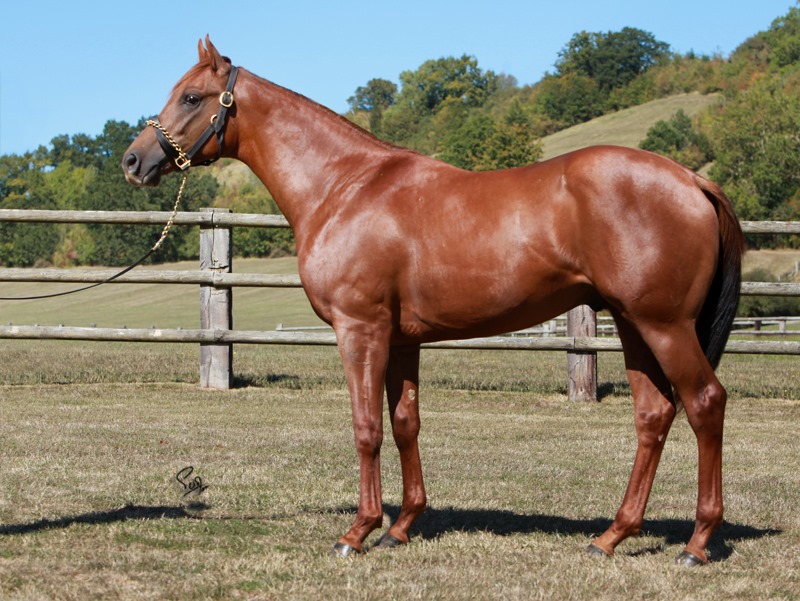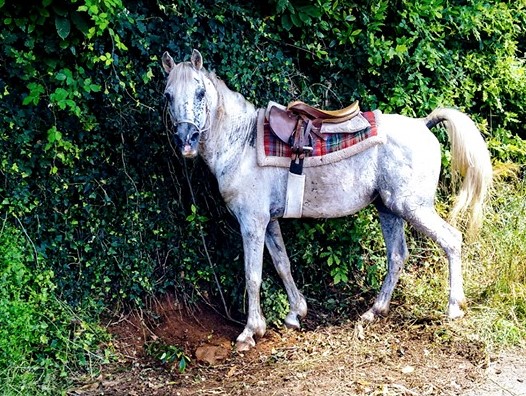Two stallions on my Facebook feed

This is Nahaab, a yearling born March 2018. I just love the “son of the desert” look and feel on him. The level croup. The high set tail. The authentic lineage. He looks like he came straight out of a black tent of Arabia. He would be a good match for my Kuhaylat. Might even help preserve their desert bloodlines.
(Just messing with you, in case you were still wondering)
For comparison, this is Najm Yarob, the Syrian stallion of Jose Manuel Meizoso in Spain. I just love the “son of the desert” look and feel on him. The level croup. The high set tail. The authentic lineage. He looks like he came straight out of a black tent of Arabia. He would be a good match for my Kuhaylat. Might even help preserve their desert bloodlines.

Some “Arab” horses have diverged so much from the original desert horse that it is high time to recognize they have become a separate breed. That applies to horses of the extreme race type as well as horses of the extreme show type, regardless of pedigree.
I like ’em both, but I did do a lot of blinking at first when reading your description of Nahaab. He looks very like a sprinter-type Thoroughbred in the body – power for shorter bursts of speed, rather than the ability to just keep on going over a hundred kilometres. Got a very deep girth, which is nice, lots of room for lungs, and I bet he would get good sport horses too! But he is so very different from Najm Yarob, who is instantly recognisable as Arabian.
At any rate, the divergence of both halter horses and racehorses from their desert ancestors is a lovely illustration of the power of selective breeding. (Though I am annoyed by the infusion of Thoroughbred blood into the racing lines, because it muddies the waters of selection here, and I would really like to see what an Arabian from lines selected for speed over short distances looks like without Thoroughbred introgression, because it would make an interesting comparison for the development of the Thoroughbred itself.)
This connects pretty well with a topic that came up in one of my horsey chat groups that is filled with non-Arabian folks, as someone shared the Arabian training martingale. One thing led to another, and then we ended up looking at the horses being longed in the training martingale and the trot action the park horses are displaying. My response was, if you’re breeding an Arabian to display a phenotype that is maximal for a high-stepping trot gait with maximum elevation of the poll, you are not breeding an Arabian, no matter what the registration papers say. The popularity of the National Show Horse and the Hackney/Arabian crosses says a lot about what folks are looking for and what they really shouldn’t be finding an an Arabian.
Nice chestnut Appendix Quarter horse! But I prefer the Arabian.
Go, Moira!
The Nahab horse at the top looks very much like a racing quarter horse. The only thing that is different in his conformation and that of an honestly labeled quarter horse is in his neck. He does have a skinny uncrested , underdeveloped neck. ( most purpose bred flat racing horses are selected for a non crested neck) However, it is set at about the half way point up his shoulder toward his withers. Sprinting quarter horses usually have their skinny little necks set at the lower end of their shoulder. In addition his hindquarters are set way higher than the top of his withers LIKE his most likely true anscestors were. I would think my money would be quite safe if I were to bet that most of the breeders of the ,’racing,’ arabians would be unwilling to have their horses Y chromosomes tested, or in the case of the mares if their Mt Dna were to be compared to known asil mare lines .
best
Bruce Peek
“Some “Arab” horses have diverged so much from the original desert horse that it is high time to recognize they have become a separate breed.”
Maybe time to stop nagging about unpure Arabians. The WAHO Pure Bred Arabian is what it is, a pure bred breed, like the thoroughbred, Lusitano or Pura Raza Espanol.
If you want to preserve the asil Arabian, the only way to do is to give them a separate studbook instead of just a label. A separate studbook & real papers distanciating them from pure breds will not only preserve them but most likely give them a value which a label alone can’t.
Combination of studbook & value will make preservation breeders start thinking out of their inbred circle and start using different asil stallions, probably automatically breeding better horses which they cannot through constant narrow inbreeding.
Patrick, that may be right, but the devil is in the details. Or, as UPS, wasn’t it? used to say, Logistics!
A Bedouin song relating to a mare: ” O sweetheart O you with a white spot on the forehead! And today where are you,treasure of mine?I followed the footprints,every little while halting,And yet I found neitherthe mistress true nor my dear mare”
@Jeanne: shipping semen around the globe is the easy part, the tricky part is on what criteria to accept horses in an asil studbook 🙂
Absolutely, Patrick. The comment about UPS was that they used to advertise themselves with the LOGISTICS term. And Logistics would be the problem in trying to work out all of the details of an asil studbook!
I keep coming back to this stallion in my mind. I really think he would match well with a good many of the Davenports.
So why not do as Edouard has previously suggested have a couple different grades of ,’asilness,’ at the top have the known from the desert, known from their breeders marbat with a Hujja and backuo genetic testing from the Y chromosome and mitochondrial dna from the dam line. Below that for example could be the horses brought in from the desert but without breeder documentation. And of course you add descending levels of proof, but require scientific documentation of all the horses listed.
best
Bruce Peek